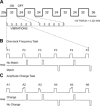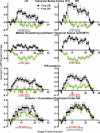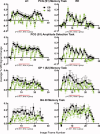Working memory for vibrotactile frequencies: comparison of cortical activity in blind and sighted individuals
- PMID: 20162595
- PMCID: PMC4100337
- DOI: 10.1002/hbm.20966
Working memory for vibrotactile frequencies: comparison of cortical activity in blind and sighted individuals
Abstract
In blind, occipital cortex showed robust activation to nonvisual stimuli in many prior functional neuroimaging studies. The cognitive processes represented by these activations are not fully determined, although a verbal recognition memory role has been demonstrated. In congenitally blind and sighted (10 per group), we contrasted responses to a vibrotactile one-back frequency retention task with 5-s delays and a vibrotactile amplitude-change task; both tasks involved the same vibration parameters. The one-back paradigm required continuous updating for working memory (WM). Findings in both groups confirmed roles in WM for right hemisphere dorsolateral prefrontal (DLPFC) and dorsal/ventral attention components of posterior parietal cortex. Negative findings in bilateral ventrolateral prefrontal cortex suggested task performance without subvocalization. In bilateral occipital cortex, blind showed comparable positive responses to both tasks, whereas WM evoked large negative responses in sighted. Greater utilization of attention resources in blind were suggested as causing larger responses in dorsal and ventral attention systems, right DLPFC, and persistent responses across delays between trials in somatosensory and premotor cortex. In sighted, responses in somatosensory and premotor areas showed iterated peaks matched to stimulation trial intervals. The findings in occipital cortex of blind suggest that tactile activations do not represent cognitive operations for nonverbal WM task. However, these data suggest a role in sensory processing for tactile information in blind that parallels a similar contribution for visual stimuli in occipital cortex of sighted.
© 2010 Wiley-Liss, Inc.
Figures






Similar articles
-
Cortical activity to vibrotactile stimulation: an fMRI study in blind and sighted individuals.Hum Brain Mapp. 2004 Dec;23(4):210-28. doi: 10.1002/hbm.20064. Hum Brain Mapp. 2004. PMID: 15449356 Free PMC article. Clinical Trial.
-
Tactile spatial working memory activates the dorsal extrastriate cortical pathway in congenitally blind individuals.Arch Ital Biol. 2008 Sep;146(3-4):133-46. Arch Ital Biol. 2008. PMID: 19378878
-
Cortical activity during tactile exploration of objects in blind and sighted humans.Restor Neurol Neurosci. 2010;28(2):143-56. doi: 10.3233/RNN-2010-0503. Restor Neurol Neurosci. 2010. PMID: 20404404
-
Cross-modal plasticity of tactile perception in blindness.Restor Neurol Neurosci. 2010;28(2):271-81. doi: 10.3233/RNN-2010-0534. Restor Neurol Neurosci. 2010. PMID: 20404414 Free PMC article. Review.
-
Neuroimaging studies of working memory: a meta-analysis.Cogn Affect Behav Neurosci. 2003 Dec;3(4):255-74. doi: 10.3758/cabn.3.4.255. Cogn Affect Behav Neurosci. 2003. PMID: 15040547 Review.
Cited by
-
How can audiovisual pathways enhance the temporal resolution of time-compressed speech in blind subjects?Front Psychol. 2013 Aug 16;4:530. doi: 10.3389/fpsyg.2013.00530. eCollection 2013. Front Psychol. 2013. PMID: 23966968 Free PMC article.
-
Recognition memory for vibrotactile rhythms: an fMRI study in blind and sighted individuals.Somatosens Mot Res. 2011;28(3-4):48-62. doi: 10.3109/08990220.2011.602765. Epub 2011 Aug 17. Somatosens Mot Res. 2011. PMID: 21846300 Free PMC article.
-
Right occipital cortex activation correlates with superior odor processing performance in the early blind.PLoS One. 2013 Aug 14;8(8):e71907. doi: 10.1371/journal.pone.0071907. eCollection 2013. PLoS One. 2013. PMID: 23967263 Free PMC article.
-
Early attentional processing and cortical remapping strategies of tactile stimuli in adults with an early and late-onset visual impairment: A cross-sectional study.PLoS One. 2024 Jul 9;19(7):e0306478. doi: 10.1371/journal.pone.0306478. eCollection 2024. PLoS One. 2024. PMID: 38980866 Free PMC article.
-
Sound-encoded faces activate the left fusiform face area in the early blind.PLoS One. 2023 Nov 22;18(11):e0286512. doi: 10.1371/journal.pone.0286512. eCollection 2023. PLoS One. 2023. PMID: 37992062 Free PMC article.
References
-
- Amedi A, Malach R, Hendler T, Peled S, Zohary E ( 2001): Visuo‐haptic object‐related activation in the ventral visual pathway. Nat Neurosci 4: 324–330. - PubMed
-
- Amedi A, Jacobson G, Hendler T, Malach R, Zohary E ( 2002): Convergence of visual and tactile shape processing in the human lateral occipital complex. Cereb Cortex 12: 1202–1212. - PubMed
-
- Amedi A, Raz N, Pianka P, Malach R, Zohary E ( 2003): Early ‘visual’ cortex activation correlates with superior verbal memory performance in the blind. Nat Neurosci 6: 758–766. - PubMed
-
- Amedi A, von Kriegstein K, van Atteveldt NM, Beauchamp MS, Naumer MJ ( 2005): Functional imaging of human crossmodal identification and object recognition. Exp Brain Res 166: 559–571. - PubMed
Publication types
MeSH terms
Grants and funding
LinkOut - more resources
Full Text Sources

